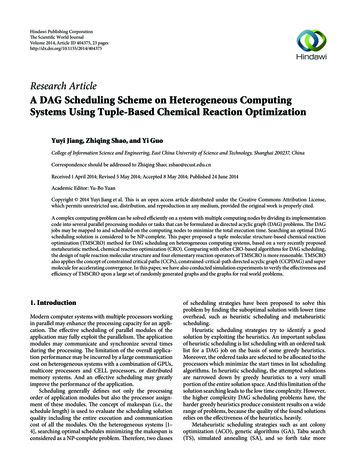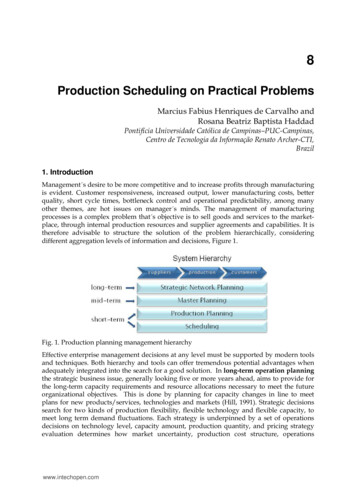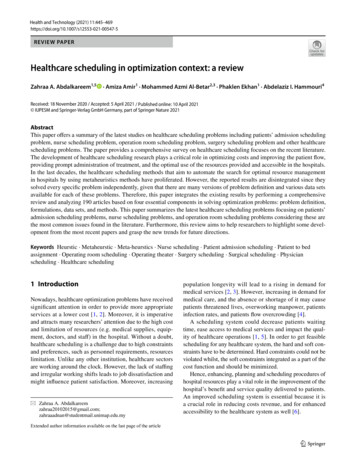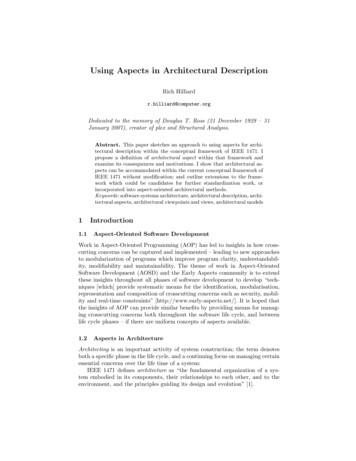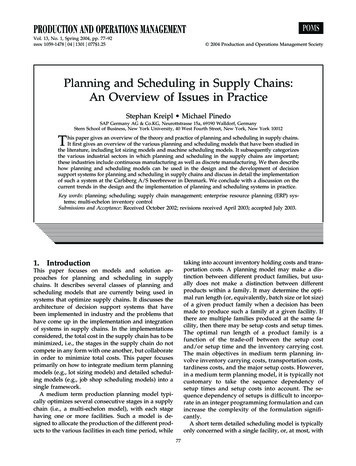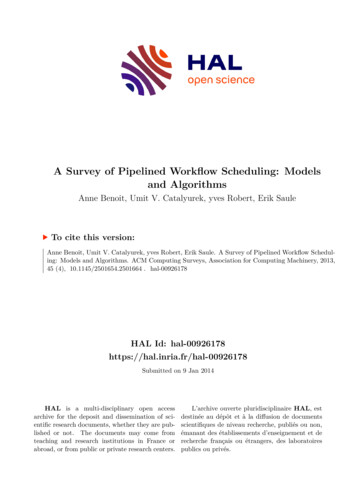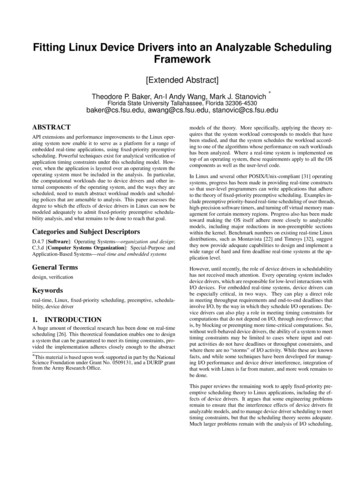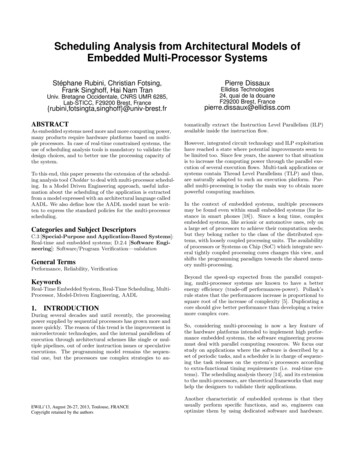
Transcription
Scheduling Analysis from Architectural Models ofEmbedded Multi-Processor SystemsStéphane Rubini, Christian Fotsing,Frank Singhoff, Hai Nam TranUniv. Bretagne Occidentale, CNRS UMR 6285,Lab-STICC, F29200 Brest, TRACTAs embedded systems need more and more computing power,many products require hardware platforms based on multiple processors. In case of real-time constrained systems, theuse of scheduling analysis tools is mandatory to validate thedesign choices, and to better use the processing capacity ofthe system.To this end, this paper presents the extension of the scheduling analysis tool Cheddar to deal with multi-processor scheduling. In a Model Driven Engineering approach, useful information about the scheduling of the application is extractedfrom a model expressed with an architectural language calledAADL. We also define how the AADL model must be written to express the standard policies for the multi-processorscheduling.Categories and Subject DescriptorsC.3 [Special-Purpose and Application-Based Systems]:Real-time and embedded systems; D.2.4 [Software Engineering]: Software/Program Verification—validationGeneral TermsPerformance, Reliability, VerificationKeywordsReal-Time Embedded System, Real-Time Scheduling, MultiProcessor, Model-Driven Engineering, AADL1.INTRODUCTIONDuring several decades and until recently, the processingpower supplied by sequential processors has grown more andmore quickly. The reason of this trend is the improvement inmicroelectronic technologies, and the internal parallelism ofexecution through architectural schemes like single or multiple pipelines, out of order instruction issues or speculativeexecutions. The programming model remains the sequential one, but the processors use complex strategies to au-EWiLi’13, August 26-27, 2013, Toulouse, FRANCECopyright retained by the authorsPierre DissauxEllidiss Technologies24, quai de la douaneF29200 Brest, Francepierre.dissaux@ellidiss.comtomatically extract the Instruction Level Parallelism (ILP)available inside the instruction flow.However, integrated circuit technology and ILP exploitationhave reached a state where potential improvements seem tobe limited too. Since few years, the answer to that situationis to increase the computing power through the parallel execution of several execution flows. Multi-task applications orsystems contain Thread Level Parallelism (TLP) and thus,are naturally adapted to such an execution platform. Parallel multi-processing is today the main way to obtain morepowerful computing machines.In the context of embedded systems, multiple processorsmay be found even within small embedded systems (for instance in smart phones [18]). Since a long time, complexembedded systems, like avionic or automotive ones, rely ona large set of processors to achieve their computation needs;but they belong rather to the class of the distributed systems, with loosely coupled processing units. The availabilityof processors or Systems on Chip (SoC) which integrate several tightly coupled processing cores changes this view, andshifts the programming paradigm towards the shared memory multi-processing.Beyond the speed-up expected from the parallel computing, multi-processor systems are known to have a betterenergy efficiency (trade-off performances-power). Pollask’srule states that the performances increase is proportional tosquare root of the increase of complexity [5]. Duplicating acore should give better performance than developing a twicemore complex core.So, considering multi-processing is now a key feature ofthe hardware platforms intended to implement high performance embedded systems, the software engineering processmust deal with parallel computing resources. We focus ourstudy on applications where the software is described by aset of periodic tasks, and a scheduler is in charge of sequencing the task releases on the system’s processors accordingto extra-functional timing requirements (i.e. real-time systems). The scheduling analysis theory [14], and its extensionto the multi-processors, are theoretical frameworks that mayhelp the designers to validate their applications.Another characteristic of embedded systems is that theyusually perform specific functions, and so, engineers canoptimize them by using dedicated software and hardware.
Hence, as a lot of designs are specific, there is a need formodeling languages which encompass both the software andhardware architecture of the system. Obviously, the modelsinclude information about the available processing units.In this context, the article investigates the ability of the architectural language AADL to model different multi-processorarchitectures, and to express significant information for controlling a multi-processor scheduling analysis tool, calledCheddar.The article is structured as follows. The section 2 presentsfoundation of real-time scheduling analysis on multi-processorsystems, and how the Cheddar tool has been adapted to support such kind of analysis. The section 3 defines the architecture of the parallel execution platforms that we considerfor the scheduling analysis. The section 4 binds this analysisto a model driven development process. In the last part, after the presentation of related works, we conclude and givesome perspectives.2.MULTI-PROCESSOR SCHEDULINGANALYSIS WITH THE CHEDDAR TOOLWe consider real-time applications which are modeled by aset of periodic tasks. For schedulability analysis, each taskTi is usually defined by four temporal parameters [14]: itsfirst release time ri , its Worst Case Execution Time (WCET)Ci which is the highest computation time of the task, its relative deadline Di which is the maximum acceptable delaybetween the release and the completion time of any instanceof the task, and its period Pi which is the fixed delay between two successive task release time. A task consists of aninfinite set of instances (or jobs) released at times ri k Pi ,where k N.From this task model, the community has proposed variousways to assess the schedulability of a real-time application.Each schedulability analysis assumes a scheduling algorithmwhich decides at each time the jobs that have to be run onthe processors. In the sequel, we first give an outline of realtime multiprocessor scheduling algorithms. Then, we showhow we have implemented them in the Cheddar tool.2.1 Multi-processor SchedulingMulti-processor scheduling is used to support multi-programming (large number of independent jobs), or to support parallel programming (dependent jobs with multiple exchanges).Given a set of jobs and a set of processors one of the question a multi-processor scheduling algorithm has to answer ishow jobs can be assigned to processors [8].We distinguish two classes of multi-processor scheduling:on a given processor, it is supposed to complete on thesame processor).This class of scheduling algorithms suffers from highrun-time overhead as the number of pre-emptions andmigrations can increase significantly. Partitioned scheduling. With partitioned scheduling,each task can only be executed on a dedicated processor and task migrations are not allowed.A significant advantage of partitioned scheduling isthat it is well-understood since schedulability analysiscan be verified with uniprocessor schedulability analysis methods. Then, classical scheduling such as EDF,RM [14] can be reused.But, finding an optimal assignment of tasks to processors is equivalent to a bin-packing problem, which isknown to be NP-hard [13]. However, many polynomialtime heuristics have been proposed for solving thisproblem [10] (First Fit, Best Fit, . . . ).Each of these approaches described above have been extended in various studies.2.2 Cheddar and Multi-processor SchedulingSupportCheddar is a schedulability tool that implements classicalschedulability methods for uniprocessor systems [17]. Tosupport scheduling analysis of multi-processor architectures,we have extended Cheddar with both partitioned and globalscheduling features.As a partitioned system can be analyzed as a set of uniprocessor subsystems, most of the Cheddar features can be usedto assess schedulability of these systems. Cheddar uniprocessor analysis features only have been extended with somesimple bin-packing algorithms in order to define processor’stasks. The currently supported bin-packing algorithms areRM Next Fit, First Fit, Best Fit, Small tasks and GeneralTasks [7].For scheduling analysis with global scheduling, Cheddar offers less features. For this class of multiprocessor architectures, Cheddar only offers scheduling analysis by schedulingsimulation. The current Cheddar implementation proposesa global scheduling algorithm for each uniprocessor algorithm (e.g. global DM/EDF/RM/LLF/.) but also somededicated gobal scheduler such as Pfair.3. MULTI-PROCESSINGTATIONIMPLEMEN- Global scheduling [3, 9]. In this approach, any instanceof any task may be executed on any processor. A jobmay halt its execution on one processor and resume iton a different processor.In this section, we describe different implementations of theconcept of multi-processing. These implementations differby the resources in the architecture which are shared whenexecuting the instruction flows. The figure 1 illustrates themajor, although not mutually exclusive, solutions: multiprocessors, multi-cores and multi-threading.Consequently, this approach assumes an execution environments which allow task migrations. Classically, atask can migrate at any time, or migration can be limited to job activation (e.g. when a task job is startedHistorically, multi-processor architectures have been the firstsolution. The processors are located on different integratedcircuits, and share the memory. Memory and bus contention
Figure 2: Analysis tool chainFigure 1: Architectural localization of the multiprocessing capabilities. The ability of executingmultiple threads may be provided at different levels:by the coupling of processor chips, inside a ”processor” chip or inside the data-path.is a major concern in this kind of architecture, and the offchip implementation of the buses limits the field of implementations that could be used to deal with this problem.The off-chip buses are also known to consume a significantpart of overall power budget [4].Today’s multi-core processors are only integrated implementations of multi-processor systems. But, the technical constraints are not the same, and more efficient solutions maybe developed to interconnect the cores and the memory hierarchy inside a chip. Multiplexed bus, crossbar switches orNetwork-On-Chip are examples of interconnect architecturesthat allow parallel transactions between cores, memories, orI/O devices.Multi-threading strategies have been introduced to increasethe usage efficiency of processing units inside the pipelineof the super-scalar processors. When the ILP is too limited and/or the execution flows are stalled, waiting for theend of memory requests, processing units are available forexecuting instructions issued from another threads.However, the concept of multi-threading inherently leads tothe sharing of the processing units of a core/processor. Inthe general case, the starting up of an additional thread impacts the performances of the other threads running on thesame processor. This implicit interference between threads1is very difficult to quantify, because it depends on the set ofinstructions, coming from the candidate threads, that canbe issued at a given time towards the processor pipelines.The next section describes how the model of a system cantake such architectures into consideration, and its exploitation to drive a multi-processor scheduling analysis.4.SCHEDULING ANALYSIS FROM AADLMODELSThe figure 2 shows the tool chain which drives the schedulinganalysis.1The same problem exists when threads share other resources like memory buses for instance.OSATE, Stood or ADELE are textual and graphical modeleditors for AADL. AADLInspector 2 is a model processingframework that is used to analyze textual AADL specifications. It includes a set of static rule checkers and bridgesfor remote verification tools, like Cheddar, or Marzhin 3 . Finally, Cheddar 4 is a real-time scheduling tool.In this section, after a short presentation of the AADL language, we discuss the deployment schemes for different multiprocessor scheduling strategies. Next, the AADL model ofa system, and a scheduling analysis is shown as an example.4.1 AADLThe Architecture Analysis & Design Language (AADL) is aSAE standard (AS-5506), first published in 2004 [12]. AADLis a modeling language for description and analysis of systemarchitecture in terms of components and their interactions.It allows the modeling of software and execution platformcomponents. The deployment of a software application onan execution platform is specified through binding properties.An AADL component is defined by a declaration and implementations. Each component relies on a category. Categories of components are related to software entities, likeprocess, thread or data, and hardware entities like processor,memory, bus or device. Each component may have severalattributes called properties. The AADL standard includesa large set of pre-declared properties to model system characteristics. Moreover, new properties can be defined to precisely describe the expected system.4.2 Modeling and Assignment of ComputingUnitsAs noticed before, AADL represents the deployment of anapplication by binding properties, and hence associates software entities to execution resources. For instance, the following property assigns the execution of a thread ta, belonging to the process as1, to a processor p1.A c t u a l P r o c e s s o r B i n d i n g ( r e f e r e n c e ( p1 ) )applies to a s 1 . ta ;Now, we will explain how this binding mechanism may beused in the multi-processing context.2AADLInspector and Stood are products of Ellidiss Technologies (www.ellidiss.com)3Marzhin, a multi-agent based simulator, is a product ofVirtualys and Ellidiss Technologies.4Cheddar may be downloaded from http://beru.univ-brest.fr/ singhoff
Partitioned Scheduling. To deal with partitioned scheduling, a list of software threads may be assigned to their targeted processors by duplicating the processor bindings forall of them. As AADL defines a processor as an executingplatform including a scheduler that manages the sharing ofits computing resources, the system is modeled as a set ofnodes with their associated local scheduling policy. Nodescan be connected by a bus component.We expect that one AADL processor should be associated toone processing unit, i.e. hardware executing one instructionflow, regardless whether this processing unit constitutes acore of a processor, or a processor as a whole (we postponethe case of multi-threading later in this section); hence, anAADL processor includes the private resources dedicatedto an instruction flow, mainly the execution pipelines andthe private cache memories (cf figure 1). Such a modelingguideline aims to exclude of the ”processor” all the sharedresources between them, in order to define independent subsystems when they do not need to interact through externalresources. Shared resources are often a bottleneck in multiprocessors or multi-cores and the models should highlightthem.Global Scheduling. A global scheduler maintains a systemwide queue of ready tasks and considers a set of processorsto execute them. An AADL processor deals with a singlehardware execution flow at a given time, and cannot be usedto model a set of processors. A first approach is to group thetarget processors into a system component, and to bind thethreads to this multi-processing system (smp in the examplebelow).and Reference Processor allow to specify the scaling factor with respect to a reference processor, and can be usedin that goal.Now, we will illustrate this guideline by modeling a simple image processing application on a multi-core executionplatform.4.3 ExampleWe have chosen the LEON4 DEMO ASIC of AEROFLEXGaisler [1] as a target platform for our case study. The keyfeatures of this Multi-Processor SoC (MPSoC) are: Dual LEON4 cores running at 200 MHz with symmetric multi-processing support. An instruction cache anda data cache are associated to each core. The LEON4core does not provide multi-threading capabilities. Many on-chip devices and IO connections: USB-2.0host/device, SVGA, Ethernet, PCI, I2C, CAN, . . .Figure 3 shows the general architecture of the SoC, structured around three types of buses: (1) the processor memorybus, a 64-bit multiplexed synchronous AMBA AHB at 200MHz, (2) the 32-bit AHB Fast I/O bus at 100 MHz, and (3)two 32-bit low latency asynchronous APB I/O buses.A c t u a l P r o c e s s o r B i n d i n g ( r e f e r e n c e ( smp ) )applies to a s 1 . ta ;An alternative binding method enumerates explicitly the setof processors involved in the scheduling.A c t u a l P r o c e s s o r B i n d i n g ( r e f e r e n c e ( smp . p1 ) , r e f e r e n c e ( smp . p2 ) )applies to a s 1 . ta ;An AADL processor includes a scheduler, of which the typeis specified by the standard property Scheduling Protocol.In the case of global scheduling, the value of this propertymust be the same for all the processors. To remove thisconsistency rule, the AADL standard could be adapted toassociate a global scheduling method to all the processingunits available within a system component.Multi-threading. Multi-threaded processors or cores allowthe parallel execution of few tasks. The AADL hardwaremodel should represent each physical thread by a processorcomponent.A pessimistic performance scaling factor may be defined, according to the maximal number of physical threads per core,in order to take into account the performance provided by aphysical thread in relation with the mono-thread core performance. The AADL standard property Scaling FactorFigure 3: Simplified architecture of the SoC, modeled with the AADL graphical notation. Roundedrectangles and ”double” rectangles represent respectively subsystems and devices.Bus utilization is a major concern in the design of a SoC; busbandwidth and device communication requirements must bebalanced. So, the organization of the AADL model followsthe bus architecture of the SoC.The next listing describes, with the AADL textual syntax, the simplified model of the subsystem connected bythe processor memory bus. The component implementation Core.Leon4 is not detailed here; mainly it defines someprocessor properties, and characteristics of its private cachelevel.system Proc Bus SystemfeaturesProc Bus : p r o v i d e s bus access ;Mem Bus0 : p r o v i d e s bus access ; bank 0
Mem Bus1 : p r o v i d e s bus access ; bank 1VGA: p r o v i d e s bus access ;end p r o c b u s s y s t e m ;system implementation Proc Bus System . SoC Leon4subcomponentsCore1: processor Core . Leon4 {S c h e d u l i n g P r o t o c o l H i g h e s t P r i o r i t y F i r s t ;}Core2: processor Core . Leon4 {S c h e d u l i n g P r o t o c o l H i g h e s t P r i o r i t y F i r s t ;};FSB: bus Communication Bus .AHB;DDR2 Ctrl : device Mem Ctrl .DDR2;Fb: device F r a m e b u f f e r .VGA;connectionsbus access FSB Core1 . Proc Bus ;bus access FSB Core2 . Proc Bus ;bus access FSB Proc Bus ;.end Proc Bus System . SoC Leon4 ;In association with the hardware model, AADL allows usto specify the software architecture. In our example, weconsider a simple image processing process; figure 4 outlinesthe processing steps, implemented by three periodic tasks.end Product . impl ;The deployment properties complete the model and bind thesoftware entities to components of the execution platform.The binding properties below define that the three threads ofour application may be executed on the two cores of the SoC.We implement a global scheduling multi-processor strategyhere.A c t u a l P r o c e s s o r B i n d i n g ( r e f e r e n c e ( Hard . Proc Bus System ) )applies to S o f t . G e t L i n e ;A c t u a l P r o c e s s o r B i n d i n g ( r e f e r e n c e ( Hard . Proc Bus System ) )applies to S o f t . Sharp ; or w i t h an e x p l i c i t l i s t o f p r o c e s s o r sA c t u a l P r o c e s s o r B i n d i n g ( r e f e r e n c e ( Hard . Proc Bus System . Core1 ) ,r e f e r e n c e ( Hard . Proc Bus System . Core2 ) )applies to S o f t . Edge ;The Gantt diagram shown in figure 5 is the partial result ofa simulation performed by the Cheddar tool. Informationprovided by the AADL model (component hierarchy, property values, and the deployment bindings) are transformedinto Cheddar’s Architecture Description Language (ADL).The three time-lines represent the instants when tasks arereleased.Figure 4: Software architecture. Rectangles anddashed parallelograms represent respectively shareddata and execution threads. Threads communicatethrough data ports, which define data dependencies.The AADL standard supplies a set of properties to qualify the behavior of real-time tasks. These properties givethe information to define the parameters of the task modelpresented in the beginning of section 2.process E d g e D e t e c t i o nend E d g e D e t e c t i o n ;process implementation E d g e D e c t e c t i o n . implsubcomponentsG e t L i n e : thread IO {D i s p a t c h P r o t o c o l P e r i o d i c ;P e r i o d 20 us ;Compute Execution Time 2 us . . 4 us ;D e a d l i n e 20 us ;P r i o r i t y 1 0 ;};Sharp : . . .end E d g e D e c t e c t i o n . impl ;Finally, the root of the model hierarchy brings together thehardware and the software view of the embedded system ina system component.system Product ; end Product ;system implementation Product . implsubcomponentsHard : system Soc . Soc Leon4 ;S o f t : process E d g e D e t e c t i o n . impl ;.properties de pl oy m e n t ( s e e b e l ow )Figure 5: Result of a Cheddar simulation. TheCheddar ADL groups in a ”Cpu” the set of processing units managed by a global scheduling algorithm.5. RELATED WORKSOther works focus on the integration of a scheduling analysisin a MDE approach. They differ from our proposition by theexpressiveness of the ADL and the analysis method that hasbeen chosen.UML/Modeling and Analysis of Real-Time and EmbeddedSystem (MARTE) profile currently supports mono and multiprocessor scheduling algorithms, but only for a partitionedapproach. [15] has proposed various updates for MARTEmetamodels of specialization and generalization stereotypein order to support global scheduling approaches, allowingtask migrations. Those changes allow a schedulable resourceto be executed on different computing resources in the sameperiod.The work in [2] describes an approach to combine MARTEand EAST-ADL2 to overcome EAST-ADL2 limitation of notions for modeling the timing features. EAST-ADL2 is anarchitecture description language defined as a domain specific language for the development of automotive electronic
systems. The MAST toolset is integrated in the MDE process to perform the scheduling analysis.An approach to extend the AADL standard properties tosupport the modeling and specification of embedded multicore system was also proposed in [11]. Analysis is performedwith a Monte-Carlo and scheduling simulation mixed approach.In [6], a verification framework for schedulability of multicore systems, called MoVES, is described. MoVES providesa simple specification language to define a system. It canmodel software components and execution platform; however, the architecture seems to be restricted to only oneprocessor bus. The analysis method is based on timed automata.6.For our future work, we plan an extension of the Cheddarsimulation framework to consider uniform processors, i.e.processors with equal capabilities but different speeds. Especially, this feature will help to integrate some of the effects related to the multi-threaded processors in the results.After that, a key point in the multi-processor analysis isto consider the sharing of resources, like buses or sharedcaches, which introduces implicit inter-processor dependencies. Extensions of the Cheddar tool to deal with some ofthese aspects will be useful, and once again precise architectural models of the computing and memory resources [16]will be his work is done in the context of the SMART project,in collaboration with Ellidiss Technologies and Virtualys.SMART is supported by the Conseil Régional de Bretagneand OSEO. Cheddar is supported by the Conseil Régionalde Bretagne and Ellidiss Technologies.8.[6]CONCLUSIONThis article has shown how scheduling analysis may be handled in a MDE process in the context of multi-processorarchitectures. The AADL language provides the means toexpress the basic information required to control a multiprocessor scheduling tool. The availability of multiples processing units extend the design space and engineers needhelp at the early stages of the design to check their choiceabout their assignment to the tasks.7.[5][14][15]REFERENCES[1] Aeroflex Gaisler. Dual core LEON4 SPARC V8Processor LEON4-ASIC-DEMO, Data Sheet andUser’s Manual, May 2011.[2] S. Anssi, S. Tucci-Pergiovanni, C. Mraidha,A. Albinet, F. Terrier, and S. Gérard. CompletingEAST-ADL2 with MARTE for enabling schedulinganalysis for automotive applications. Embedded RealTime Software and Systems, Toulouse, France, 2010.[3] S. K. Baruah, N. K. Cohen, C. G. Plaxton, and D. A.Varvel. Proportionate progress: A notion of fairness inresource allocation. Journal of Algorithmica,15(6):600–625, 1996.[4] K. Basu, A. Choudhary, J. Pisharath, andM. Kandemir. Power protocol: reducing power[16][17][18]dissipation on off-chip data buses. In Proceedings ofthe 35th Annual IEEE/ACM International Symposiumon Microarchitecture, pages 345–355, June 2002.S. Borkar. Thousand core chips: a technologyperspective. In Proceedings of the 44th annual DesignAutomation Conference, pages 746–749. ACM, 2007.A. Brekling, M. R. Hansen, and J. Madsen. MoVES-aframework for modelling and verifying embeddedsystems. In Proceedings of the IEEE InternationalConference on Microelectronics, pages 149–152, 2009.A. Burchard, J. Liebeherr, Y. Oh, and S. Son.Assigning real-time tasks to homogeneousmultiprocessor systems. IEEE Transactions onComputers, 44(12):1429–1442, December 1995.J. Carpenter, S. Funk, P. Holman, A. Srinivasan,J. Anderson, and S. Baruah. A categorization ofreal-time multiprocessor scheduling problems andalgorithms. Leung, J. Y.-T., editor, Handbook ofScheduling: Algorithms, Models, and PerformanceAnalysis. CRC Press LLC., 2003.H. Cho, B. Ravindran, and D. Jensen. An optimalreal-time scheduling algorithm for multiprocessors. InProceedings of the 27th IEEE International Real-TimeSystems Symposium, pages 101–110. IEEE, 2006.E. G. Coffman, G. Galambos, S. Martello, andD. Vigo. Bin packing approximation algorithms:Combinational analysis. Kluwer Academic Publishers,1998.M. Deubzer, M. Hobelsberger, J. Mottok, F. Schiller,R. Dumke, M. Siegle, U. Margull, M. Niemetz, andG. Wirrer. Modeling and simulation of embeddedreal-time multicore systems. In Proceedings of the 3rdEmbedded Software Engineering Congress, pages228–241, 2010.P. Feiler, B. Lewis, and S. Vestal. The SAE AADLstandard: A basis for model-based architecture-drivenembedded systems engineering. In Workshop onModel-Driven Embedded Systems, May 2003.J. Y.-T. Leung and J. Whitehead. On the complexityof fixed-priority scheduling of periodic, real-time tasks.Performance evaluation, 2(4):237–250, 1982.C. L. Liu and J. W. Layland. Scheduling algorithmsfor multiprogramming in a hard real-timeenvironnment. Journal of the Association forComputing Machinery, 20(1):46–61, Jan. 1973.A. Magdich, Y. H. Kacem, A. Mahfoudhi, andM. Abid. A MARTE extension for global schedulinganalysis of multiprocessor systems. In Proceedings ofthe 23rd IEEE International Symposium on SoftwareReliability Engineering, pages 371–379, 2012.S. Rubini, F. Singhoff, and J. Hugues. Modeling andverification of memory architectures with AADL andREAL. In Sixth IEEE International Workshop onUML and AADL, pages 338–343, USA, April 2011.F. Singhoff, J. Legrand, L. Nana, and L. Marcé.Cheddar: a Flexible Real-Time SchedulingFramework. ACM SIGAda Ada Letters, ACM Press,New York, USA, 24(4):1–8, Dec. 2004.C. Van Berkel. Multi-core for mobile phones. InProceedings of the Conference on Design, Automationand Test in Europe, pages 1260–1265. EuropeanDesign and Automation Association, 2009.
This class of scheduling algorithms suffers from high run-time overhead as the number of pre-emptions and migrations can increase significantly. Partitioned scheduling. With partitioned scheduling, each task can only be executed on a dedicated proces-sor and task migrations are not allowed. A significant advantage of partitioned .
